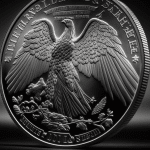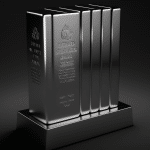You could be overwhelmed with choices when it comes to selecting an investment strategy that will help you save for retirement and unsure of which one is best for you—including silver, which could be the silver bullet for retirement investing.
To find out the answer to the age-old question, “Is silver a smart retirement investment?” it's crucial to comprehend the benefits and drawbacks of investing in silver before making the plunge into the realm of precious metals.
We'll go deep into the world of silver investment in this article, covering all you need know before making a choice.
Investing in Silver for Retirement
Investing in silver for retirement is becoming increasingly popular among those looking for a more tangible asset to add to their retirement portfolio. While silver may not be as visible as stocks, bonds and mutual funds, it does offer investors some interesting possibilities. Silver is a precious metal that doesn't always correlate with the stock market and can be bought in physical form which can make it an attractive alternative to other assets.
The main argument in favor of investing in silver for retirement is that the metal has had historic value and could potentially provide better returns than other investments.
When compared to other metals like gold, silver prices have been relatively low over the past ten or so years, making it a more affordable option.
Additionally, world demand for silver has increased significantly due to industrial uses such as electronics production and solar energy panels, further increasing its potential as a worthwhile investment.
On the flip side, investing in silver can be riskier than other investments. Since demand for silver is largely tied to industrial output, any significant decline in production could lead directly to lower prices and reduced gains for investors. Furthermore, buying real silver coins and bars carries additional storage costs and requires insurance protection, which can add up quickly .
Considering all these factors before investing in physical silver is essential since there are high risks involved. The volatility of the silver market should also be taken into account and a careful approach should be adopted by investors who are considering purchasing this metal for their retirement portfolios.
With all these points in mind, what are the advantages of silver as an investment? In the next section we will discuss these advantages in greater detail and why they represent a potentially attractive opportunity for those looking to diversify their retirement wealth.
What are the Pros of Silver as an Investment?
Silver has become increasingly popular with more attention from financial media and non-traditional retirement account providers educating the public that silver is a top investment choice for retirement portfolios, and there are several reasons why.
First, silver is a hard asset with not only industrial purposes, but wealth protection too. As with gold, silver is a form of money and a true commodity. It’s considered a safer investment choice with a lower correlation to stock markets, which provides greater diversification toward a paper asset-heavy financial portfolio. This can enable investors to hedge against any downturns in the stock market while still maintaining upside potential. It also helps build a better inflation-proof investment portfolio, with a long track record of reducing the negatives in inflationary periods for maintaining wealth.
In addition to the above advantages, silver investments may offer other unique strengths such as greater liquidity than other investments and the potential for significant returns due to its limited supply. The relatively low cost of entry also makes silver appealing to those on tight budgets or just starting off their investing journey. On the other hand, silver prices can be volatile, making it difficult to perfectly time market entries and exits in order to maximize profits.
These benefits of investing in silver demonstrate why more investors are turning to this precious metal as part of their retirement strategy and why it deserves further consideration. Let's examine how silver investments can improve monetary stability going forward.
Crucial Points
In recent years, silver’s popularity has gained greater attention as an investment choice for retirement portfolios due to its relatively low correlation to stock markets, inflation-hedge, greater liquidity than other investments, the potential for significant returns, low cost of entry, and the long track record of price appreciation. Although silver prices can be volatile, they offer advantages that make it a valuable addition to any investor’s retirement strategy. Financial stability can also be enhanced through silver investments.
Financial Stability through Silver Investments
Silver can offer long-term financial stability for individuals who are looking to invest for retirement. As a valuable metal, silver provides comparable advantages and benefits to other precious metals like gold or platinum. Silver has historically proven to be a reliable and stable investment option, providing investors with a steady return over time, even when other investments may be volatile.
Yet, some contend that because of its price volatility and small market size, silver may not be the ideal choice when it comes to retirement investments. Silver can rise quickly in price during uncertain economic times, but also drop just as quickly if the demand isn't there. So investors should weigh both the potential profits and losses carefully before investing any significant amount of money into silver.
Despite potential drawbacks, many investors choose silver as an attractive alternative investment due to its stability relative to other markets. Its high liquidity and low overhead costs contribute to its appeal among retirement investors who want to ensure their security over the long term. By diversifying portfolios among different investments, retirees may be able to protect themselves from economic downturns and safeguard their savings for generations to come.
Ultimately, although there are risks associated with silver investments, many consider them worth it for the stability they bring to retirement portfolios. As with any type of investment, investors must do their research prior to committing funds, being aware of potential losses alongside potential gains. With careful planning and informed decision-making, individuals who invest in silver strategically may achieve greater financial security in retirement.
By understanding the advantages of incorporating silver into their retirement strategies, retirees can gain greater control over their financial future. In the following section we will explore what assets can be bought with silver and how investors can capitalize on this popular investment vehicle for greater long-term prosperity.
What Assets can be Bought with Silver?

Generally speaking, investments in silver can either be physical silver bullion or silver coins. Both offer investors and savers different advantages and considerations.
Silver bullion come only in a few approved sizes, classed by their weight in troy ounces. While these are typically the most cost effective way to invest in silver, they are not often marked with identifying mint marks or mottos. Because they aren't as easily identifiable they may lack the numismatic value that collectors seek when investing.
On the other hand, silver coins have a very attractive design with specific mint marks and mottos. This makes them easier to identify and appraise their value if collectors are interested in buying them. Coins often have a higher premium than bullion itself and can be very profitable when selling to coin collectors.
Overall each option has its own advantages and drawbacks that investors must evaluate based on their needs and risk tolerance when choosing what assets to buy with their silver investment. Practice due diligence and seek guidance from a qualified precious metals advisor that is familiar with alternative asset retirement investing, such as through a self-directed gold or silver IRA. Take your time before investing at once with your hard-earned retirement wealth.
The following section will explore another important question: Silver Bullion vs Silver Coins – which should an investor choose?
Silver Bullion vs. Silver Coins

Silver bullion and silver coins are your two primary investing options when it comes to silver. Silver bullion typically refers to bars, ingots, and rounds in various sizes and weights, while silver coins are struck by government mints and feature specific designs considered legal tender in their respective countries.
Both forms of physical silver can offer beneficial advantages for retirement investments. Silver bullion is typically lower in cost per ounce compared to silver coins, since additional factors such as rarity and collectibility of the coin do not come into play. Additionally, with silver bullion, investors can purchase a large quantity of ounces with a relatively small cash outlay. However, some buyers enjoy the creativity behind specially minted coins that have designs that may interest them more than plain-looking silver bullion bars.

In terms of potential resale value, silver bullion may offer better flexibility because its worth is determined solely by the weight and purity of the metal. Silver coins may be more challenging to price in a short time frame due to the variations in design and rarity associated with each coin type. Furthermore, finding a willing buyer may also be more difficult due to the nature of the specific coin being sold.
Ultimately, both types of physical silver are viable choices when investing for retirement purposes. When deciding what type is best for you, consider your goals and objectives carefully to see which option provides the level of accuracy and liquidity that works for your needs.
Now that we've discussed two popular ways to invest in silver–silver bullion and silver coins–the next section will look at what standard is used when investing in the precious metal. What’s the Standard for Silver Investing?
- According to precious metal investment firm GoldSilver.com, silver has historically been a much better investment than gold when considering returns over a decade or longer.
- According to Money Metals Exchange, silver has outperformed gold by more than 5x since 1970 and has shown more consistent long-term growth over time.
- Silver prices have consistently outperformed inflation over the last twenty years—being 4x higher in real terms, whereas gold prices only doubled.
What’s the Standard for Silver Investing?
Most people are familiar with the standard investment options, such as stocks and bonds. Financial advisors often recommend these, often advising a 60/40 basket of them. And often the only choices for traditional IRAs and 401(k) plans. But many people are unsure about whether silver is a good investment, such as silver in a self-directed IRA.
Silver is considered a precious metal, but should it be part of your retirement portfolio? It's important to understand the standard for silver investing before making any decisions.
The primary benefit of silver lies in its value as both a commodity and an investment asset. Silver has historically been used for currency and jewelry, but industrial demand for silver has increased in recent years as more companies look to use technology powered by silver, such as in medical wound dressings, medical equipment, solar panels, and electric vehicles (EVs).
As an investment asset, silver provides regular returns with minimal risk since its spot price rarely suffers drastic shifts. The value of silver also tends to increase over time because its supply is finite. On the other hand, some investors may feel conservative about leaving part of their retirement funds tied up in an investment that is not paper-backed or derives much of its value from industrial use instead of its intrinsic value.
Additionally, market drops are highly likely if silver does not climb higher than the current spot price due to high trading volumes which may leave investors with losses on their hands.
Before committing any funds to a silver investment strategy, it’s important to familiarize yourself with the bearish and bullish sides of this precious metal. Consider factors including supply and demand trends as well as general market conditions before investing in silver for retirement security. This allows you to make informed decisions that maximize your return over time in a risk-managed manner.
With this knowledge under your belt, it’s now time to look at the benefits of a balanced retirement portfolio that encompasses multiple asset classes such as stocks and bonds alongside less conventional investments like silver.
Benefits of a Balanced Retirement Portfolio
Retirement planning is an important factor for individuals looking to secure their financial future. Having a balanced portfolio allows investors to diversify investments and reduce the risk of major losses due to market swings. A balanced approach that incorporates silver, stocks, bonds and other investments can help protect your nest egg and offer various benefits over time.
For starters, balancing your investments may produce higher returns than putting all of your money into any one asset class. This comes from the ability to shift funds between different types of investments as markets rise or fall. You don't need a thorough understanding of the markets in order to be successful; simply staying informed about trends can provide you with enough information to make wise decisions.
On the other hand, silver is only one element of a successful retirement portfolio. Stocks, bonds and other investment products have been proven time and time again to generate substantial returns for those who remain patient and have realistic expectations. Taking on more risk may also yield higher rewards, but such a tactic should only be used sparingly for those who can weather market volatility.
Overall, creating a balanced retirement portfolio is essential for long-term success. Silver can play an important role within such a plan, but it should not be the sole focus or investment strategy. Keeping your goals in mind while diversifying across numerous asset classes could be the key to achieving your desired results.
Having discussed the importance of a balanced retirement portfolio, the next section will focus on exploring the Value and Price of Silver in greater detail.
The Value and Price of Silver
The worth and cost of silver can change significantly based on a number of variables, including the rate of inflation at the time and the state of the world economy. Silver has traditionally been seen as a hedge against inflation because it does not depreciate in its real value, even when currencies do. As such, investors may view silver as a good option for retirement investments, as its stable value holds up despite market turmoil and other economic fluctuations.
However, the purchase and sale of gold, silver, and other tradeable commodities is governed by market forces just like any other investment. As such, the price of silver can be highly volatile. While experienced investors may find this volatility appealing, those without sufficient knowledge or research skills could end up losing money if they buy and sell at inopportune times.
Moreover, investing heavily in silver may affect the diversity of an investor's retirement portfolio.
There are no guarantees that it will continue to be a safe investment against inflation even if historically it has been. Thus, making sure to spread out investments in stocks, bonds and other financial instruments remains important to ensure long-term returns during retirement years.
In conclusion, silver can be a good addition to an overall retirement strategy but should not be relied upon for total security against inflation or as a main source of revenue during retirement years. To reap maximum benefit from investing in silver for the long-term requires thoughtful research into overall market conditions and balancing with alternative investments for added diversity. In the next section we will explore concluding thoughts on whether silver is worth an investment for retirement goals.
Conclusion
After carefully evaluating the pros and risks of investing in silver for your retirement, one conclusion may be drawn: silver can indeed be a good investment for retirement. Silver is an often overlooked, undervalued asset but its stability over time, use as both a commodity and currency, and potential growth have given it great appeal, especially during uncertain economic times. While investing in silver can come with risks, it also presents potentially impressive potential percentage gain higher than gold due to its price-to-gold ratio.
When considering investing in silver, it's crucial to evaluate the current market and make sure you're aware of any associated risk. Furthermore, when planning an investment strategy, consult a certified financial planner to ensure that silver fits into your overall portfolio and helps meet your goals.
In summary, retirement investing doesn’t have to be weighted only to stocks, bonds, and CDs. Silver has shown value and profit potential throughout history. Therefore, adding silver to your retirement portfolio could be the perfect opportunity for you to develop a reliable retirement strategy that can protect long-term wealth accumulation.
If you would like to know more about adding silver to your retirement portfolio through Silver IRAs, head over to our 2023 report on the top Silver IRA companies for this year.
Risk Disclosure: Any investments into alternative assets, including precious metals, such as gold, silver, platinum, and palladium, come with an inherent risk, where you could end up making less money than what you put in. Before investing your hard-earned cash, be sure to speak with licensed professional financial advisor first. Always remember that past performance is not an indication of future returns.
Disclaimer: The website's owners of Cryptowealthbay.com may be compensated for suggesting certain businesses, goods, and services. While we do everything possible to verify that all of our content is accurate, the information we provide may not be impartial or unbiased, and it does not constitute financial advice.



